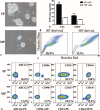COX-2 Promotes Migration and Invasion by the Side Population of Cancer Stem Cell-Like Hepatocellular Carcinoma Cells
- PMID: 26554780
- PMCID: PMC4915881
- DOI: 10.1097/MD.0000000000001806
COX-2 Promotes Migration and Invasion by the Side Population of Cancer Stem Cell-Like Hepatocellular Carcinoma Cells
Abstract
Cancer stem cells (CSCs) are thought to be responsible for tumor relapse and metastasis due to their abilities to self-renew, differentiate, and give rise to new tumors. Cyclooxygenase-2 (COX-2) is highly expressed in several kinds of CSCs, and it helps promote stem cell renewal, proliferation, and radioresistance. Whether and how COX-2 contributes to CSC migration and invasion is unclear. In this study, COX-2 was overexpressed in the CSC-like side population (SP) of the human hepatocellular carcinoma (HCC) cell line HCCLM3. COX-2 overexpression significantly enhanced migration and invasion of SP cells, while reducing expression of metastasis-related proteins PDCD4 and PTEN. Treating SP cells with the selective COX-2 inhibitor celecoxib down-regulated COX-2 and caused a dose-dependent reduction in cell migration and invasion, which was associated with up-regulation of PDCD4 and PTEN. These results suggest that COX-2 exerts pro-metastatic effects on SP cells, and that these effects are mediated at least partly through regulation of PDCD4 and PTEN expression. These results further suggest that celecoxib may be a promising anti-metastatic agent to reduce migration and invasion by hepatic CSCs.
Conflict of interest statement
The authors have no conflicts of interest to disclose.
Figures






Similar articles
-
ELK3 promotes the migration and invasion of liver cancer stem cells by targeting HIF-1α.Oncol Rep. 2017 Feb;37(2):813-822. doi: 10.3892/or.2016.5293. Epub 2016 Dec 7. Oncol Rep. 2017. PMID: 27959451
-
MicroRNA-21 regulates the migration and invasion of a stem-like population in hepatocellular carcinoma.Int J Oncol. 2013 Aug;43(2):661-9. doi: 10.3892/ijo.2013.1965. Epub 2013 May 27. Int J Oncol. 2013. PMID: 23708209
-
Expression of intercellular adhesion molecule 1 by hepatocellular carcinoma stem cells and circulating tumor cells.Gastroenterology. 2013 May;144(5):1031-1041.e10. doi: 10.1053/j.gastro.2013.01.046. Epub 2013 Jan 31. Gastroenterology. 2013. PMID: 23376424
-
Stem cells in hepatocarcinogenesis: evidence from genomic data.Semin Liver Dis. 2010 Feb;30(1):26-34. doi: 10.1055/s-0030-1247130. Epub 2010 Feb 19. Semin Liver Dis. 2010. PMID: 20175031 Free PMC article. Review.
-
5-methoxyindole metabolites of L-tryptophan: control of COX-2 expression, inflammation and tumorigenesis.J Biomed Sci. 2014 Mar 3;21(1):17. doi: 10.1186/1423-0127-21-17. J Biomed Sci. 2014. PMID: 24589238 Free PMC article. Review.
Cited by
-
Meeting the Challenge of Targeting Cancer Stem Cells.Front Cell Dev Biol. 2019 Feb 18;7:16. doi: 10.3389/fcell.2019.00016. eCollection 2019. Front Cell Dev Biol. 2019. PMID: 30834247 Free PMC article. Review.
-
Cyclooxygenase-2 expression is associated with initiation of hepatocellular carcinoma, while prostaglandin receptor-1 expression predicts survival.World J Gastroenterol. 2016 Oct 21;22(39):8798-8805. doi: 10.3748/wjg.v22.i39.8798. World J Gastroenterol. 2016. PMID: 27818595 Free PMC article.
-
Cancer stem cells in hepatocellular carcinoma: an overview and promising therapeutic strategies.Ther Adv Med Oncol. 2018 Dec 21;10:1758835918816287. doi: 10.1177/1758835918816287. eCollection 2018. Ther Adv Med Oncol. 2018. PMID: 30622654 Free PMC article. Review.
-
Enhancing Anti-Tumor Activity of Sorafenib Mesoporous Silica Nanomatrix in Metastatic Breast Tumor and Hepatocellular Carcinoma via the Co-Administration with Flufenamic Acid.Int J Nanomedicine. 2020 Mar 16;15:1809-1821. doi: 10.2147/IJN.S240436. eCollection 2020. Int J Nanomedicine. 2020. PMID: 32214813 Free PMC article.
-
Targeting the eicosanoid pathway in hepatocellular carcinoma.Am J Cancer Res. 2021 Jun 15;11(6):2456-2476. eCollection 2021. Am J Cancer Res. 2021. PMID: 34249410 Free PMC article. Review.
References
-
- Torre LA, Bray F, Siegel RL, et al. Global cancer statistics, 2012. CA Cancer J Clin 2015; 65:87–108. - PubMed
-
- Guo Z, Zhong JH, Jiang JH, et al. Comparison of survival of patients with BCLC stage a hepatocellular carcinoma after hepatic resection or transarterial chemoembolization: a propensity score-based analysis. Ann Surg Oncol 2014; 21:3069–3076. - PubMed
-
- Ueno M, Uchiyama K, Ozawa S, et al. Adjuvant chemolipiodolization reduces early recurrence derived from intrahepatic metastasis of hepatocellular carcinoma after hepatectomy. Ann Surg Oncol 2011; 18:3624–3631. - PubMed
-
- Chaffer CL, Weinberg RA. A perspective on cancer cell metastasis. Science 2011; 331:1559–1564. - PubMed
Publication types
MeSH terms
Substances
LinkOut - more resources
Full Text Sources
Medical
Research Materials

